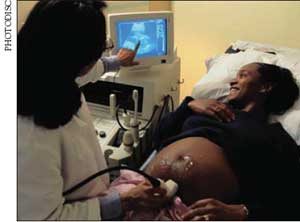Vital Signs:
OBNet project gives
much more choice
to mothers-to-be
Is it possible to have a safe vaginal birth after a cesarean section? With no national standards, lots of negative press, and high malpractice awards, many New Hampshire and Vermont hospitals didn't want to find out; 16 closed their doors to women wanting a vaginal birth after a cesarean (VBAC).
In 1999, Dr. Michele Lauria at DHMC and Dr. Eleanor Capeless at the University of Vermont's Fletcher Allen Health Care decided to stop the twin states' decline in VBACs. They mapped out a plan-calling it the VBAC Project-to ensure the procedure's safety and increase its availability.

|
| More options for mothers-to-be is the mission of a network headed by DHMC and UVM's Fletcher Allen. |
Interested ob-gyns were invited to a series of open meetings to create VBAC guidelines, consent forms, and educational materials for both doctors and patients. The resources were posted on the Web (at www.nneob.org).
"VBAC is an incredible controversy, and people are passionate about it," says Lauria. "Those who disagree with VBAC say it puts the providers and the patients at risk. Those of us who agree with VBAC feel that the risk is not so high as to limit patient choice, and that patients are the best people to decide what happens to their bodies.
"The issue was critical for both states," she adds, "and galvanized us together."
Improvement: The group's next step was to find out if their educational materials were making a difference. In October of 2002, members of the VBAC Project created the Northern New England Perinatal Quality Improvement Network (NNEPQIN), a voluntary consortium of hospitals throughout the region. From that collaboration came OBNet, a registry developed at Fletcher Allen to collect detailed information about births in the region. "It's difficult to do really good quality improvement work," says Lauria, "but this is especially true in small hospitals. We wanted to put data on the Web and open it up to smaller hospitals in both states."
OBNet went live at Fletcher Allen in November 2003 and at DHMC two months later. With a central registry, there is now consistent and complete regional data to base quality improvement on. The database can generate reports sorted by patient or provider information, and providers can use the data for medical decision-making.
As a result, there's now more choice for pregnant women. "Since the VBAC Project finished its work, no additional hospitals withdrew services and two hospitals reopened services," says Lauria. "There are additional hospitals that are thinking of reopening their VBAC services. I suspect that this will happen over the next year."
NNEPQIN is about to roll out a second set of educational materials, this time for emergency cesarean sections. "We drilled down and looked at every step in the process, creating resources from a simulation tool to outcome tracking tools," says Lauria. "An emergency C-section is a procedure that you don't do that often but when it happens, time is critical. Hospitals need to simulate and train for that situation so there aren't any surprises. Now everyone doesn't have to recreate the wheel."
Award: The group's work has not gone unnoticed. Lauria is regularly quoted in the regional and national press about the initiative (see page 25), and the VBAC Project received the 2004 American College of Obstetricians and Gynecologists Wyeth-Ayerst Section Award for most outstanding activity in a district. Nine hospitals now belong to NNEPQIN, and Lauria gets requests for information about the project every day.
"We've been busy. We've been effective," she says. "The consortium combines our collective intellects to create solutions for common problems."
If you would like to offer any feedback about this article, we would welcome getting your comments at DartMed@Dartmouth.edu.
